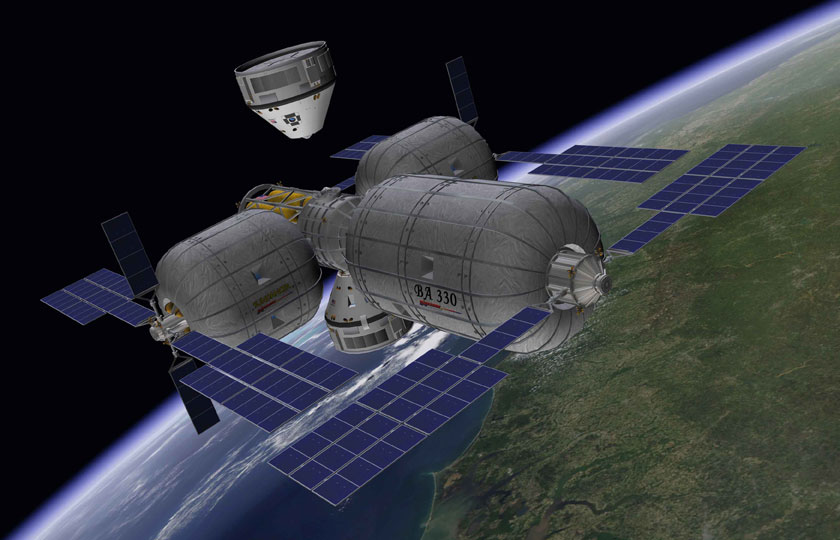
NASA's decision to buy an inflatable new room for the International Space Station may push the module's builder —commercial spaceflight company Bigelow Aerospace — one step closer to establishing its own private stations in orbit.
Last week, NASA announced that it will pay $17.8 million for the Nevada-based company's Bigelow Expandable Activity Module (BEAM), which will be affixed to the huge orbiting lab as a technology demonstration.
NASA and Bigelow will discuss the deal during a media event Wednesday (Jan. 16) in North Las Vegas, where the company is headquartered. BEAM could help prove out the viability of inflatable crew habitats, potentially jump-starting Bigelow's ambitious plans in low-Earth orbit and, perhaps, on the surface of the moon.
Expanding access to space
Bigelow Aerospace was founded in 1999 by Robert Bigelow, who made his fortune in real estate and finance. He also owns the Budget Suites of America hotel chain, for example. [Photos: Bigelow's Inflatable Space Station Idea]
Bigelow Aerospace specializes in expandable habitats, which launch in a compact form and then inflate upon reaching space. The company says expandable modules offer greater on-orbit volume and better protection against radiation and micrometeoroid strikes than traditional "tin can" designs can provide.
Inflatable modules were first pursued seriously by NASA, which developed a design called TransHab (short for "Transit Habitat") for possible use on the International Space Station. When Congress cancelled the TransHab program in 2000, Bigelow officials licensed the patents and began adapting the technology for the company's own purposes.
Get the Space.com Newsletter
Breaking space news, the latest updates on rocket launches, skywatching events and more!
The company's goals are big: to establish private space stations that could be used by many different clients for a variety of purposes, from research to tourism.
"We are primarily focused on providing sovereign clients (individual or groups of nations) and companies with the opportunity to lease space and resources aboard our habitats for a broad array of activities, ranging from turn-key astronautics to conducting ground-breaking and lucrative biotech research," Bigelow Aerospace's website states.
"We offer a way for countries to bolster their human spaceflight programs while at the same time reducing their budgets, or for smaller countries that thought human spaceflight was beyond their financial reach to enjoy capabilities that until now only the wealthiest nations have been able to sponsor."
Making it happen
Bigelow has already put hardware into space, launching the prototype modules Genesis 1 and Genesis 2 to orbit in 2006 and 2007, respectively.
Both Genesis habitats are 14.4 feet long by 8.3 feet wide (4.4 by 2.5 meters), with about 406 cubic feet (11.5 cubic m) of pressurized volume. The BEAM module that will be attached to the International Space Station in two years or so will likely be of similar size.
But Bigelow is developing a much larger module, called the BA-330 because it offers 330 cubic meters of usable internal volume. The company envisions linking up two or more BA-330s in orbit to create its first space stations, which have already attracted attention from potential clients.
For example, Bigelow has signed memoranda of understanding with seven governments that wish to use the company's orbiting facilities — Australia, Singapore, the United Kingdom, the Netherlands, Japan, Sweden and Dubai, in the United Arab Emirates.
Bigelow will offer a variety of rental packages to its clients when the stations are up and running, perhaps starting with $28.75 million for an all-inclusive 30-day stay for one astronaut (the company has quoted this figure in the past).
Clients may have several different ways to reach Bigelow's habitats. The company has set up a partnership with the California-based firm SpaceX to use its Dragon spacecraft, and another with Boeing for use of its CST-100 capsule.
Bigelow's dreams don't stop in low-Earth orbit. Robert Bigelow has voiced an interest in setting up outposts on the moon, which would employ BA-330 habitats that are joined together in space, flown down to the lunar surface and then covered with moon dirt to protect against radiation, temperature extremes and micrometeorite impacts.
As such ambitious goals demonstrate, Bigelow seeks to fundamentally transform the way humanity uses space, opening up the final frontier to greater exploration and exploitation.
"Mr. Bigelow created Bigelow Aerospace with the express purpose of revolutionizing space commerce via the development of affordable, reliable and robust expandable space habitats," the company's website states.
Follow SPACE.com senior writer Mike Wall on Twitter @michaeldwall or SPACE.com @Spacedotcom. We're also on Facebook and Google+.
Join our Space Forums to keep talking space on the latest missions, night sky and more! And if you have a news tip, correction or comment, let us know at: community@space.com.

Michael Wall is a Senior Space Writer with Space.com and joined the team in 2010. He primarily covers exoplanets, spaceflight and military space, but has been known to dabble in the space art beat. His book about the search for alien life, "Out There," was published on Nov. 13, 2018. Before becoming a science writer, Michael worked as a herpetologist and wildlife biologist. He has a Ph.D. in evolutionary biology from the University of Sydney, Australia, a bachelor's degree from the University of Arizona, and a graduate certificate in science writing from the University of California, Santa Cruz. To find out what his latest project is, you can follow Michael on Twitter.









